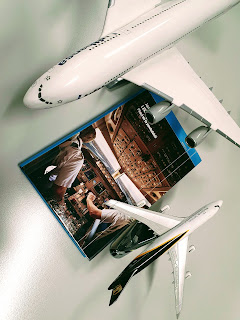Piękno czterech pór roku
Do tej pory
przeczytałam już kilka powieści Ali Smith i jej styl jest niepodrabialny.
Dlatego gdy wyszła czwarta, ostatnia część tetralogii Pory roku nie mogłam się powstrzymac i kupiłam całość w pięknym
wydaniu WAB. Szkoda jednak, że nie zachowano szaty graficznej oryginalnego
wydania z obrazami Hockney’a. Polskie wydanie, choć piękne, jednak trochę na
tym traci.

Smith dość długo
nosiła się z zamiarem napisania czterech książek związanych z porami roku. Gdy
jej wydawca zaakceptował ten ryzykowny pomysł (książki, powstające co rok,
miały odnosić sie do bieżących wydarzeń i być wydawane w rekordowo krótkim
czasie sześciu tygodni), szkocka pisarka zabrała się do pracy. Książki są ze
sobą połączone nie tylko budową (każda z części danej pory roku ma 3
podsumowania kolejnych miesięcy, stanowiące jedne z najpiękniejszych opisów
przyrody, jakie kiedykolwiek widziałam), ale bohaterami czy stylem. Smith pisze
patchworkowo, nie waha się cytować innych dzieł literackich, gazet, tweetów, a
w każdej części przybliża innego artystę i odnosi się do dzieła wiodącego.
Dlatego w mojej recenzji w ten właśnie sposób odniosę się do każdej z części po
kolei – krótko omówię fabułę, zwrócę uwagę na literaturę i sztukę przywołaną w
utworze oraz na bieżące i dawniejsze wydarzenia historyczne.
Jesień (Autumn) – Co czytasz?
Fabuła: Wieloletnia historia
przyjaźni starszego już Daniela Glucka z dziewczynką Elisabeth Demand. 11-latka
została sąsiadką już wtedy posuniętego w latach mężczyzny, a jej matka często
zostawiała córkę pod jego opieką. Daniel wprowadził Elisabeth w świat
literatury i sztuki, wspierał w trudnych chwilach, otwierał jej wyobraźnię.
Sztuka: Pauline Boty,
przedstawicielka brytyjskiego pop-artu.
Literatura: Aldous Huxley, Nowy wspaniały świat; Owidiusz, Przemiany; Shakespeare.
Wydarzenia historyczne:
głosowanie w sprawie Brexitu, nastroje narodowościowe, rok 2016, protesty
przeciwko amerykańskiemu atakowi na Irak po atakach z 11 września, afera
Profumo (romans modelki Christine Keeler z premierem Haroldem Macmillanem,
który pogrążył jego rząd).
Zima (Winter) – Sztuka w
naturze
Fabuła: Sophia Cleves widzi
bezcielesną głowę, która się zmienia i towarzyszy kobiecie przez jakiś czas. Na
Boże Narodzenie odwiedza ją syn Arthur z dziewczyną Charlotte oraz siostra
Iris, z którą Sophia od lat nie utrzymywała kontaktu. Kłopot polega na tym, że
mężczyzna rozstał się z prawdziwą Charlotte i nie wie, jak powiedzieć o tym
matce, więc zatrudnia przypadkowo poznaną dziewczynę, Lux, by ją zastąpiła
podczas świąt. Właśnie ta dziewczyna wydobędzie z matki Arthura najbardziej
skrywaną tajemnicę o ojcu jej syna.
Sztuka: Barbara Hepworth,
rzeźbiarka; Giotto.
Literatura: Charles Dickens, Opowieść wigilijna; Shakespeare, Cymbelin.
Wydarzenia historyczne: obóz
pokoju w Greenham z 1981 roku w proteście przeciwko jądrowym zbrojeniom; fala
imigrantów próbujących się dostać do Europy; prezydentura Donalda Trumpa.
Wiosna (Spring) – Dzięchuje
Fabuła: Richard Lease, reżyser
filmowy, wysiada na przypadkowej stacjii w Szkocji (Kingussie) i będzie
usiłował popełnić samobójstwo, kładąc się pod koła pociągu. Uratuje go
dziwaczna postać, Florence, 12-letnia dziewczynka, która wcześniej odwiedziła strzeżony
ośrodek dla cudzoziemców, w którym pracuje druga kluczowa postać, Brittany Hall.
Po rozmowie z dziewczynką wszystkie sanitariaty zostają dokładnie wyszorowane,
a warunki dla przetrzymywanych tam ludzi nieco się poprawiają. Florence
podróżuje wraz z Brit aż do Szkocji, gdzie ich ścieżki krzyżują się z
nieszczęśliwym i podrążonym w żałobie po śmierci swojej wieloletniej
przyjaciółki i kochanki Patricii Heal Richardem. W tle sieć Auld Alliance,
pomagająca imigrantom zdobyć brytyjską tożsamość i osiedlić się w kraju.
Smith nabija się
również przy okazji ze współczesnej sztuki filmowej (pod postacią scenarzysty
Martina Terpa), który pisze sceny erotyczne pomiędzy Rilkem a Mansfield, którzy
w rzeczywistości nigdy się nie spotkali. Seks w wagoniku kolejki linowej
pomiędzy dwoma gigantami liteartury XX wieku?
Sztuka: Tacita Dean, rysunki gór
kredą na tablicy.
Literatura: Rainer Maria Rilke;
Katherine Mansfield, Dzienniki oraz Listy; Charles Dickens, Opowieść o Richardzie Dubeltowym; Percy
Bysshe Shelley, Chmura.
Wydarzenia historyczne: Brexit,
zamieszki w Irlandii z 1922 po zabójstwie Michaela Collinsa; krwawa niedziela w
Londonderry z 1972; skazanie Maguire’ów w 1976 roku; Windrush, Greenfell;
kryzys migracyjny.
Lato (Summer) – w lecie chodzi o wyobrażony koniec
Fabuła: Sacha Greenlaw i jej
młodszy brat Robert mieszkają wraz z rozwiedzioną matką w Brighton. Robert robi
swojej siostrze psikusa, przyklejając jej do dłoni klepsydrę na plaży i ucieka.
Dziewczynkę do domu odprowadzają Charlotte i Arthur, których znamy z części
drugiej. Podczas rozmowy z nowo poznanymi ludżmi matka zgadza się pojechać z
nimi i dziećmi do Suffolk, gdzie w młodości występowała w sztuce Shakespeare’a.
Chłopiec ma fioła na punkcie Einsteina, a dziewczyna pisuje listy o jerzykach do
osadzonego w ośrodku SOC-u imigranta Hero.
Daniel Gluck
wspomina swój pobyt w obozie dla cudzoziemców w Ascot w Wielkiej Brytanii podczas
drugiej wojny światowej, gdzie był wraz z ojcem przetrzymywany jako obywatel
wrogiego państwa. Jego siostra Hannah Gluck pomaga w czasie wojny przekraczać
ludziom granice w poszukiwaniu bezpieczeństwa. Do Daniela, obecnie
przebywającego w domu opieki, przyjeżdża Arthur (by oddać mu kamień, fragment
rzeżby Barbary Hepworth) i tak poznaje Elisabeth, w której się zakochuje.
Tymczasem Charlotte
mieszka z ciotką Arta, Iris, w jej wielkim domu. Dawna aktywistka postanawia
przyjąć pod swój dach grupę imigrantów zwolnionych z SOCu – wśród nich jest i
Hero, a właściwie Anh Kiệt.
Sztuka: Lorenza Mazetti,
reżyserka filmowa i malarka; Fred Uhlman, rysunki tuszem.
Literatura: Charles Dickens, David Copperfield; William Shakespeare, Zimowa opowieść; Rilke, Wazon
róż.
Wydarzenia historyczne: II wojna
światowa, przetrzymywanie obywateli wrogich państw w obozach na terenie
Wielkiej Brytanii, kryzys migracyjny, Brexit.
 Z każdą swoją
książką Smith udowadnia, że wiele jest jeszcze w literaturze do zrobienia,
wiele granic do przesunięcia, zabiegów stylistycznych do wykorzystania. W
żadnej innej twórczości tak nie widać pracy na żywym organizmie prozy. Pisarka
odważnie korzysta zarówni z klasyki brytyjskiej (i nie tylko), jak i ze
współczesnych tekstów kultury. Jednocześnie udowadnia, że jest uważnym
obserwatorem i uczestnikiem świata sztuki.
Z każdą swoją
książką Smith udowadnia, że wiele jest jeszcze w literaturze do zrobienia,
wiele granic do przesunięcia, zabiegów stylistycznych do wykorzystania. W
żadnej innej twórczości tak nie widać pracy na żywym organizmie prozy. Pisarka
odważnie korzysta zarówni z klasyki brytyjskiej (i nie tylko), jak i ze
współczesnych tekstów kultury. Jednocześnie udowadnia, że jest uważnym
obserwatorem i uczestnikiem świata sztuki.
Pory roku sprytnie
się łączą w finalnym tomie Lato,
bohaterowie wskakują na swoje miejsca, a ich relacje wyjaśniają się i zaczynają
ściśle łączyć. Powieści można czytać osobno, choć polecałabym czytać czteropak
jako całość i w odpowiedniej kolejności (pierwsza była Jesień). Niektóre wątki przeplatają się we wszystkich czterech
tomach (postać i twórczość Charliego Chaplina, opisy przyrody, korporacja
SA4A), ale każda część stanowi piękną i poruszającą etiudę. Moje jedyne
zastrzeżenie dotyczy bardzo mocnego umiejscowienia powieści w czasie i
współczesnej polityce. Obawiam się, że dzieło Smith może się przez to szybciej
zestarzeć. Z przyjemnością powrócę do niego za parę lat, żeby się o tym przekonać.
 Moja ocena: 8/10.
Moja ocena: 8/10.
Ali Smith, Jesień
Wydawnictwo WAB, Warszawa 2021 Tłumaczenie: Jerzy Kozłowski
Liczba stron: 304
ISBN: 978-83-280-6016-6
Ali Smith, Zima
Wydawnictwo WAB, Warszawa 2021 Tłumaczenie: Jerzy Kozłowski
Liczba stron: 320
Ali Smith, Wiosna
Wydawnictwo WAB, Warszawa 2021 Tłumaczenie: Jerzy Kozłowski
Liczba stron: 320
ISBN: 978-83-280-8765-1
Ali Smith, Lato
Wydawnictwo WAB, Warszawa 2021
Tłumaczenie: Jerzy Kozłowski
Liczba stron: 384
ISBN: 978-83-280-8968-6
_____________________________________________________________________
So far I have read a few of Ali
Smith's novels and her style is unmistakable. That's why when the fourth and
final part of the Season's tetralogy
was released, I couldn't help but buy the whole thing in a beautiful edition by
the WAB Publishing House. It is a pity, however, that the artwork of the
original edition with Hockney's paintings has not been preserved. The Polish
edition, although beautiful, loses a bit of it.
Smith’s been planning writing
four books related to the seasons. Once her publisher accepted this risky idea
(the books, produced one each year, were to relate to current events and be
published in an extremely short time of six weeks), the Scottish writer went to
work. Books are linked not only by their structure (each part of a given season
has 3 summaries of the following months, which are one of the most beautiful
descriptions of nature I have ever read), but by characters or style. Smith
writes in patchworks, does not hesitate to quote other literary works,
newspapers, tweets, and each part introduces a different artist and refers to
the leading work. That is why in my review this is how I will refer to each book
as well - I will briefly discuss the plot, pay attention to the literature and
art referred to in the work, as well as current and past historical events.
Autumn - What
are you reading?
Plot: The long story of
friendship between the older Daniel Gluck and the girl Elisabeth Demand. The
11-year-old became a neighbor of an already advanced-in-years man, and her
mother often left her daughter in his care. Daniel introduced Elisabeth to the
world of literature and art, supported her in difficult times, sculptured her
imagination.
Art: Pauline Boty, female
representative of British pop art.
Literature: Aldous
Huxley, Brave New World; Ovid, Transformations; Shakespeare.
Historical events:
Brexit vote, national sentiment, 2016, protests against the US attack on Iraq
after the 9/11 attacks, the Profumo scandal (model Christine Keeler's romance
with Prime Minister Harold Macmillan who plunged his government).
Winter - Art in nature
Plot: Sophia Cleves
sees a disembodied head that changes in time and accompanies the woman for a
while. At Christmas, she is visited by her son Arthur with his girlfriend
Charlotte and later on by her sister Iris, with whom Sophia has not been in
contact for years. The trouble is, the man broke up with the real Charlotte and
doesn't know how to tell his mother about it, so he hires a girl he
accidentally meets, Lux, to replace her during the holidays. It is this girl
who will extract from Arthur's mother the most hidden secret about the father
of her son.
Art: Barbara Hepworth,
sculptor; Giotto.
Literature: Charles
Dickens, A Christmas Carol;
Shakespeare, Cymbelin.
Historical events: the
1981 Greenham Peace Camp in protest against nuclear weapons; wave of immigrants
trying to enter Europe; presidency of Donald Trump.
Spring - Thuck you
Plot: Richard Lease, a
film director, gets off at a random station in Scotland (Kingussie) and will try
to commit suicide by lying under the wheels of the train. He will be saved by a
bizarre figure, Florence, a 12-year-old girl who previously visited a guarded
center for foreigners where another key character, Brittany Hall, works. After
talking to the girl, all toilets are thoroughly scrubbed, and the conditions
for the people detained there improve slightly. Florence travels with Brit as
far as Scotland, where their paths cross with Richard, unhappy and mourning
after the death of his longtime friend and lover Patricia Heal. In the
background, the Auld Alliance network, helps immigrants acquire a British
identity and settle in the country.
Smith also makes fun of the
contemporary film art (in the guise of screenwriter Martin Terp), who writes
erotic scenes between Reiner Maria Rilke and Katherine Mansfield who have never
actually met. Sex in a cable car between two giants of the 20th century
literature?
Art: Tacita Dean, chalk
drawings of mountains on a blackboard.
Literature: Rainer
Maria Rilke; Katherine Mansfield, Journals
and Letters; Charles Dickens, The
Tale of Richard Dubeltowy; Percy Bysshe Shelley, Cloud.
Historical events:
Brexit, the 1922 riots in Ireland after the murder of Michael Collins;
Londonderry's Bloody Sunday 1972; the conviction of the Maguires in 1976;
Windrush, Greenfell; migration crisis.
Summer - summer
is about an imaginary end
Plot: Sacha Greenlaw
and her younger brother Robert live with their divorced mother in Brighton.
Robert plays a trick on his sister by sticking a sandglass to her hand on the
beach and runs away. The girl is escorted home by Charlotte and Arthur, whom we
know from the second part. While talking to new people, the mother agrees to
travel with them and the children to Suffolk, where she starred in a
Shakespeare play in her youth. The boy is crazy about Einstein, and the girl
writes letters about swifts to the immigrant Hero imprisoned in the SOC center.
Daniel Gluck recalls his stay at
the Ascot foreigner camp in Great Britain during the Second World War, where he
and his father were held as a citizen of a hostile country. His sister Hannah
Gluck helps people cross borders in search of safety during the war. Arthur
comes to Daniel, currently in the nursing home (to give him a stone, a fragment
of Barbara Hepworth's sculpture), and this is how he meets Elisabeth, with whom
he falls in love.
Meanwhile, Charlotte lives with
Art's aunt Iris in her big house. The former activist decides to take under her
roof a group of immigrants released from SOC - among them there is Hero, or
rather Anh Kiệt.
Art: Lorenza Mazetti,
film director and painter; Fred Uhlman, ink drawings.
Literature: Charles
Dickens, David Copperfield; William
Shakespeare, The Winter's Tale;
Rilke, Vase of Roses.
Historical events:
World War II, detention of citizens of hostile countries in camps in Great
Britain, migration crisis, Brexit.
With each of his books, Smith
proves that there is still much to be done in literature, many boundaries to be
shifted, many stylistic procedures to be used. No other work presents the scale
of work done on the body of literature. The writer boldly uses both British (and
other) classics and contemporary cultural texts. At the same time, she proves
to be an attentive observer and participant of the world of Art.
The Seasons are
cleverly combined in the final volume of Summer,
where the characters jump into their places, and their relationships clear up
and begin to tightly connect. The novels can be read separately, although I
would recommend reading the four-pack as a whole and in the correct order (Autumn was the first one). Some themes
are intertwined in all four volumes (Charlie Chaplin's character and work,
nature descriptions, SA4A corporation), but each part is a beautiful and
touching etude. My only objection is to the novel's very strong place in time
and contemporary politics. I am afraid that Smith's work may age faster because
of this. I will be happy to come back to it in a few years to find out.
My rating: 8/10.
Ali Smith, Autumn
Publishing House: WAB, Warszawa 2021
Translation: Jerzy Kozłowski
Number of pages: 304
ISBN: 978-83-280-6016-6
Ali Smith, Winter
Publishing House: WAB, Warszawa 2021
Translation: Jerzy Kozłowski
Number of pages: 320
Ali Smith, Spring
Publishng House: WAB, Warszawa 2021
Translation: Jerzy Kozłowski
Number of pages: 320
ISBN: 978-83-280-8765-1
Ali Smith, Summer
Publishing House: WAB, Warszawa 2021
Translation: Jerzy Kozłowski
Number of pages: 384
ISBN: 978-83-280-8968-6










































